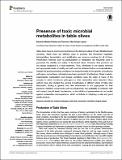Por favor, use este identificador para citar o enlazar a este item:
http://hdl.handle.net/10261/124429COMPARTIR / EXPORTAR:
 SHARE SHARE
 CORE
BASE CORE
BASE
|
|
| Visualizar otros formatos: MARC | Dublin Core | RDF | ORE | MODS | METS | DIDL | DATACITE | |

| Título: | Presence of toxic microbial metabolites in table olives |
Autor: | Medina Pradas, Eduardo CSIC ORCID ; Arroyo López, Francisco Noé CSIC ORCID | Fecha de publicación: | 28-ago-2015 | Editor: | Frontiers Media | Citación: | Frontiers in Microbiology 6: 873 (2015) | Resumen: | © 2015 Medina-Pradas and Arroyo-López. Table olives have an enormous importance in the diet and culture of many Mediterranean countries. Albeit there are different ways to produce this fermented vegetable, brining/salting, fermentation, and acidification are common practices for all of them. Preservation methods such as pasteurization or sterilization are frequently used to guarantee the stability and safety of fermented olives. However, final products are not always subjected to a heat treatment. Thus, microbiota is not always removed and appropriate levels of acidity and salt must be obtained before commercialization. Despite the physicochemical conditions not being favorable for the growth of foodborne pathogens, some illness outbreaks have been reported in the literature. Street markets, inappropriate manipulation and storage conditions were the origin of many of the samples in which foodborne pathogens or their metabolites were detected. Many authors have also studied the survival of pathogens in different styles of table olive elaboration, finding in general that olive environment is not appropriate for their presence. Inhibitory compounds such as polyphenols, low availability of nutrients, high salt content, low pH levels, bacteriocins, or the addition of preservatives act as hurdles against undesirable microorganisms, which contribute to obtaining a safe and good quality product. | Versión del editor: | http://dx.doi.org/10.3389/fmicb.2015.00873 | URI: | http://hdl.handle.net/10261/124429 | DOI: | 10.3389/fmicb.2015.00873 | Identificadores: | issn: 1664-302X |
| Aparece en las colecciones: | (IG) Artículos |
Ficheros en este ítem:
| Fichero | Descripción | Tamaño | Formato | |
|---|---|---|---|---|
| Frontiers_Microbiol_2015_V6_A873.pdf | 190,39 kB | Adobe PDF |  Visualizar/Abrir |
CORE Recommender
PubMed Central
Citations
13
checked on 29-abr-2024
SCOPUSTM
Citations
31
checked on 10-may-2024
WEB OF SCIENCETM
Citations
26
checked on 25-feb-2024
Page view(s)
268
checked on 11-may-2024
Download(s)
392
checked on 11-may-2024

